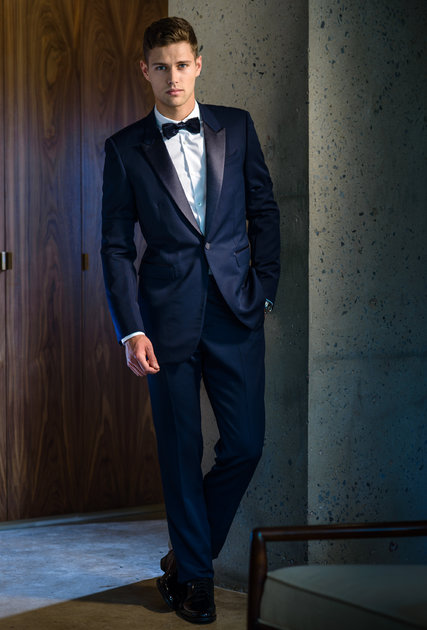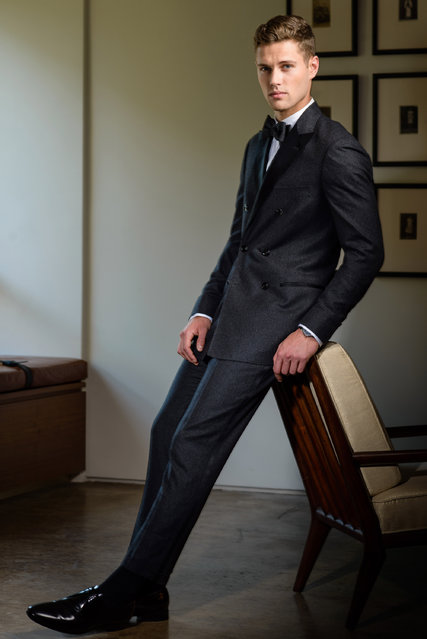By Roger Stone
This is a great article on evening clothes, dinner jackets and the origins of the incorrect but virtually universally used term Tuxedo.
Midnight Blue however has always been the proper color for a dinner suit. Thats because under some light black looks green. The Duke of Windsors famous shawl collar dinner jacket was midnight blue with a black grosgrain lapel.
Now of course every gentleman should own a set of dinner clothes but if you must rent for a formal occasion go here https://theblacktux.com/
Kudos to Guy Trebay and the New York Times for this on-point update on the man in the Tuxedo
By Guy Trebay
It’s the garment no man ever thinks about until he has to, the suit that strikes terror in an average guy’s heart. Subject to archaic codes of sartorial etiquette, composed of curious components, seemingly too expensive to buy for one-time use and yet vaguely forlorn when rented, it is, of course, the tuxedo — that set of formal clothes even whose name is controversial. (“Dinner jacket” is preferred by fancy folks.)
There was a time in a long-ago period that we’ll call the Age of Astaire when men wore suits to work and hats in town and grew up absorbing codes of dress that, though they now seem arcane, had a useful purpose. The rules as laid down over the centuries since that unassailable uniform called a suit long made it easy for men to form decisions about what they put on their bodies and when. This was all before Casual Friday came along, an event equivalent in sartorial terms to the burning of the library at Alexandria. The scrolls of wisdom were destroyed.
“The No. 1 thing guys ask is, ‘What are the rules?’ ” said Nick Sullivan, the fashion director of Esquire and author of the magazine’s Ask Nick Sullivan column. “The more I get asked, the more I want to say, ‘I couldn’t care less.’ ”
Naturally Mr. Sullivan did not intend that in literal terms. If you don’t care about rules, after all, you don’t write a column called Ask Nick. What Mr. Sullivan meant, he went on to explain, is that rules are there to be broken. A template exists. Once a man learns it, he is free to ignore the knowledge, a truth made clear at the recent Metropolitan Museum of Art’s big Costume Institute gala, where celebrity guests and the designers who clothe them interpreted a Ruritanian dress code of white-tie and tails with liberality.
Sure, some like Marc Jacobs dressed in immaculate get-ups right out of “The Grand Budapest Hotel,” a kind of counter-radical gesture from the man who once showed up at this same party in a shirtdress. Equally, though, guests took the invitation as a chance to experiment with a strict format. They wore natty Gucci tuxedos (Ryan Reynolds) and peak lapel Calvin Klein evening jackets, in white (Bryan Cranston). They strode the red carpet in Thom Browne versions of a tailcoat that smacked of Ringling Brothers and Barnum & Bailey (Neil Patrick Harris and David Burtka). They experimented with gray from Band of Outsiders (Andrew Garfield). They put their tailors to the test, as in the case of Amar’e Stoudemire, whose custom suit from Lanvin had trousers with a 38-inch inseam.
Tellingly, though, many did as the actor Chiwetel Ejiofor chose to do and turned up in evening clothes of midnight blue, a color so ubiquitous during the never-ending awards season (see: Jason Sudeikis, Kevin Spacey at the Oscars; Ryan Gosling at Cannes), it became the new black.
In bending convention, these men also managed to make dressing up for evening look fun. Why not? “Ladies like to put on nice dresses for special occasions,” Christian R. Sonne said. “Why shouldn’t men?”
As the president of the Tuxedo Historical Society in Tuxedo Park, N.Y., Mr. Sonne knows a bit about tuxedos, since he is often called on to dispel the considerable misinformation in circulation about a garment named for this upstate enclave of the moneyed elite.
“There are so many theories” about how the tuxedo got its name, Mr. Sonne said, before citing an explanation recorded by “a deceased previous longtime member” of the local historical society, who got it from one of the club’s original founders, Grenville Kane.
It was in summer 1886 that James Brown Potter, a Tuxedo Park resident, and his beautiful wife, Cora Potter, a Southerner, went to England to meet the Prince of Wales. The prince, indifferent to American social climbers but fond of pretty women, invited the Potters to spend the weekend at Sandringham. Dress-code quandaries are nothing new, and when Mr. Potter asked about what to wear for a country dinner at the 20,000-acre Norfolk estate belonging to the royal family, the prince dispatched him to his London tailor, Henry Poole & Co.
Potter returned to Tuxedo Park wearing the new truncated version of the once-requisite tailcoats, which was quickly taken up by other members of the club for informal dinners. Eventually, the new suit went into wider circulation and came to be known as the style that gents preferred nowadays for dinner “up in Tuxedo.” And in the mystifying organic way neologisms have of entering the language, the coinage stuck.
And while there are many who question this version of the tuxedo creation myth, there is little dispute about what classically constitutes a tuxedo or dinner jacket: a dark suit with satin or grosgrain facing on lapels and buttons; a similar stripe on the trouser outseam, worn with a white shirt, black bow tie, black shoes and an always-evolving array of accessories that may include (or not) cuff links, stud sets, suspenders and the now-all-but-forgotten cummerbund.
What is often overlooked about the tuxedo is that, stuffy as it seems, it is fundamentally a casual version of yet more formal attire. There are those who, like Jake Gallagher, a 22-year-old who blogs about men’s wear on A Continuous Lean, hold that the traditional elements function so well there is little need to monkey with them.
“I tend to believe you should keep it as classic as possible,” Mr. Gallagher said at a recent luncheon at Da Silvano, hosted by the Florentine trade fair Pitti Immagine.And what constitutes classic, in Mr. Gallagher’s estimation?
“In my eyes, it’s a single-button, shawl-collared jacket, grosgrain down the sides of the pants,” he said. “If not black, then midnight blue, and as clean and simple as possible, very little if anything added or changed.”
It takes considerable assurance, he added, to force change on a foolproof formula. “If you’re going to go to a formal event and wear a vibrant bow tie or a super-loud pair of shoes, you better have the confidence to carry it out,” he added. “ The designers dressing celebrities are using them, in a way. You often see celebrities dressed up by designers, and they don’t look 100 percent confident, and that’s quite tragic.”
Unsurprisingly, designers view things differently.
“As girls interpret a theme their way, why not the guys?” said Italo Zucchelli, the Calvin Klein men’s wear designer. “Why be so literal? If you know the rules, you can bend the rules and interpret them your way.”
Yet the rules themselves are no matter of universal agreement, least of all among those like Mr. Zucchelli, who, responding to the uptick in formal dressing, aggressively tweak the traditional uniform.
Consider, for instance, the sleek midnight-blue suit that Christopher Bailey, the Burberry designer and chief executive, designed for Burberry Prorsum, with its stovepipe narrow legs; or the charcoal-gray cashmere double-breasted tuxedo created this season by Brunello Cucinelli, an Italian label that over the last decade has found a particular sweet spot in the luxury sportswear market, becoming a kind of Gap for billionaires.
Even up in the sartorial blue seats, designers have taken note of a renewed interest in formal dressing.
“Guys are ready to dress up a little more, but on their own terms,” said Frank Muytjens, the head of men’s design at J. Crew.
At J. Crew, that means producing a full line of tuxedos in trim cuts and unorthodox fabrications. “Before, if you needed a tuxedo, you rented them and got something that was boxy, with shiny seams,” Mr. Muytjens said. “By cleaning it up, making it a more fitted suit and a little shorter, it helped in teaching guys how to dress.”
His goal with tuxedos is to demystify something that, he said, “people think they can wear only for weddings or formal occasions.” By recasting the tuxedo in fabrics like Japanese seersucker, lightweight Italian chino and even chambray, “we’re dusting it off again.”
Mr. Muytjens laughed then and added: “I want to take the tuxedo out of the world of stuffy formal men’s wear. To me, it’s just a sports coat with peaked lapels.”










LEAVE A COMMENT